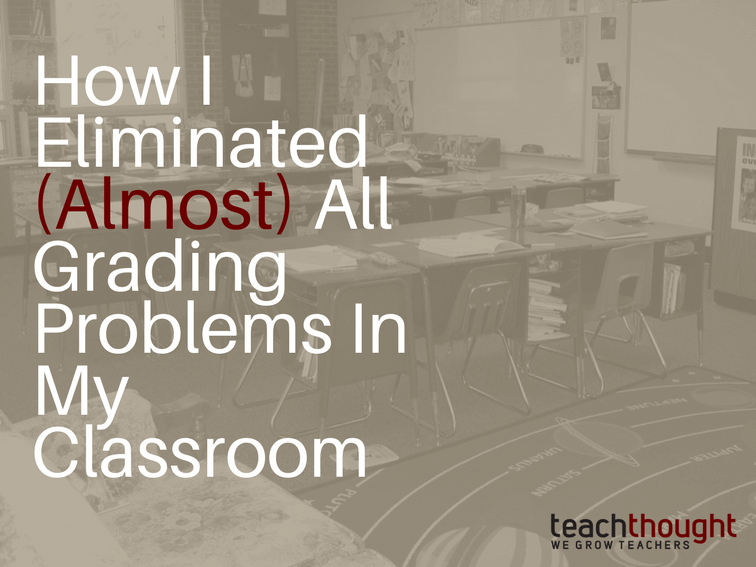I Eliminated (Almost) All Grading Problems In My Classroom
by Terry Heick
Grading problems are one of the most urgent bugaboos of good teaching.
Grading can take an extraordinary amount of time. It can also demoralize students, get them in trouble at home, or keep them from getting into a certain college.
It can demoralize teachers, too. If half the class is failing, any teacher worth their salt will take a long, hard look at themselves and their craft.
So over the years as a teacher, I cobbled together a kind of system that was, most crucially, student-centered. It was student-centered in the sense that it was designed for them to promote understanding, grow confidence, take ownership, and protect themselves from themselves when they needed it.
Some of this approach was covered in Why Did That Student Fail? A Diagnostic Approach To Teaching. See below for the system–really, just a few rules I created that, while not perfect, went a long way towards eliminating the grading problems in my classroom.
Which meant students weren’t paralyzed with fear when I asked them to complete increasingly complex tasks they were worried were beyond their reach. It also meant that parents weren’t breathing down my neck ‘about that C-‘ they saw on Infinite Campus, and if both students and parents are happy, the teacher can be happy, too.
How I Eliminated (Almost) All Grading Problems In My Classroom
1. I chose what to grade carefully.
When I first started teaching, I thought in terms of ‘assignments’ and ‘tests.’ Quizzes were also a thing.
But eventually I started thinking instead in terms of ‘practice’ and ‘measurement.’ All assessment should be formative, and the idea of ‘summative assessment’ makes as much sense as ‘one last teeth cleaning.’
The big idea is what I often call a ‘climate of assessment,’ where snapshots of student understanding and progress are taken in organic, seamless, and non-threatening ways. Assessment is ubiquitous and always-on.
A ‘measurement’ is only one kind of assessment, and even the word implies ‘checking in on your growth’ in the same way you measure a child’s vertical growth (height) by marking the threshold in the kitchen. This type of assessment provides both the student and teacher a marker–data, if you insist–of where the student ‘is’ at that moment with the clear understanding that another such measurement will be taken soon, and dozens and dozens of opportunities to practice in-between.
Be very careful with what you grade, because it takes time and mental energy–both finite resources crucial to the success of any teacher. If you don’t have a plan for the data before you give the assessment, don’t give it, and certainly don’t call it a quiz or a test.
2. I designed work to be ‘published’
I tried to make student products–writing, graphic organizers, podcasts, videos, projects, and more–at the very least visible to the parents of students. Ideally, this work would also be published to peers for feedback and collaboration, and then to the public at large to provide some authentic function in a community the student cares about.
By making student work public (insofar as it promoted student learning while protecting any privacy concerns), the assessment is done in large part by the people the work is intended for. It’s authentic, which makes the feedback loop quicker and more diverse than one teacher could ever hope to make it.
What this system loses in expert feedback that teacher might be able to give (though nothing says it can’t both be made public and benefit from teacher feedback), it makes up for in giving students substantive reasons to do their best work, correct themselves, and create higher stands for quality than your rubric outlined.
3. I made a rule: No Fs and no zeroes. A, B, C, or ‘Incomplete’
First, I created a kind of no-zero policy. Easier said than done depending on who you are and what you teach and what the school ‘policy’ is and so on. The idea here, though, is to keep zeroes from mathematically ruining a student’s ‘final grade.’
I try to explain to students that a grade should reflect understanding, not their ability to successfully navigate the rules and bits of gamification stuffed into most courses and classrooms. If a student receives a D letter grade, it should be because they have demonstrated an almost universal inability to master any content, not because they got As and Bs on most work they cared about but Cs or lower on the work they didn’t, and with a handful of zeroes thrown in for work they didn’t complete ended up with a D or an F.
Another factor at work here is marking work with an A, B, C, or ‘Incomplete.’ Put another way, if the student didn’t at least achieve the average mark of C, which should reflect average understanding of a given standard or topic, I would mark it ‘Incomplete,’ give them clear feedback on how it could be improved, and then require them to do so.
4. I went over missing assignments frequently.
Simple enough. I had a twitter feed of all ‘measurements’ (work they knew that counted towards their grade), so they didn’t have to ask ‘what they were missing’ (though they did anyway). I also wrote it on the board (I had a huge whiteboard that stretched across the front of the classroom).
5. I created alternative assessments.
Early on in teaching, I noticed students saying, in different ways, that they ‘got it but don’t all the way get it.’ Or that they believed that they did, in fact, ‘get it’ but not the way the assessment required (reminder: English Lit/ELA is a highly conceptual content area aside of the skills of literacy itself).
So I’d create an alternative assessment to check and see. Was the assessment getting in the way–obscuring more than it revealed? Why beat my head against the wall explaining the logistics of an assignment or intricacies of a question when they assignment and the question weren’t at all the points? These were just ‘things’ I used the way a carpenter uses tools.
Sometimes it’s easier to just grab a different tool.
I’d also ask students to create their own assessments at times. Show me you understand. It didn’t always work the way you’d expect, but I got some of the most insightful and creative expression I’ve ever seen from students using this approach. As with most things, it just depended on the student.
6. I taught through micro-assignments.
Exit slips were one of the the greatest things that ever happened to my teaching. I rarely used them as ‘exit tickets’ to be able to leave the classroom, but I did use them almost daily. Why?
They gave me a constant stream of data for said ‘climate of assessment,’ and it was daily and fresh and disarming to students because they knew it was quick and if they failed, another one would be coming soon.
It was a ‘student-centered’ practice because it protected them. They had so many opportunities and, math-wise, so many scores that unless they failed everything every day, they wouldn’t ‘fail’ at all. And if they were,
I could approach a single standard or topic from a variety of angles and complexities and Bloom’s levels and so on, which often showed that the student that ‘didn’t get it’ last week more likely just ‘didn’t get’ my question.
In other words, they hadn’t failed my assessment; my assessment had failed them because it had failed to uncover what they, in fact, knew.
7. I used diagnostic teaching
You can read more about diagnostic teaching but the general idea is that I had a clear sequence I used that I communicated very clearly to the students and their families. It usually took the first month or two for everyone to become comfortable with it all, but once I did, grading problems were *almost* completely eliminated. Problems still surfaced but with a system in place, it was much easier to identify exactly what went wrong and why and communicate it all to the stakeholders involved in helping support children.

